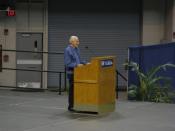Assisted Suicide Valerie Palmer
SOC 355 July 11, 2014
In 1997 the State of Oregon legalized Physician Assisted Suicide. It is also referred to as passive euthanasia. Merriam-Webster's Dictionary defines euthanasia as "the act or practice of killing or permitting the death of hopelessly sick or injured individuals (as persons or domestic animals) in a relatively painless way for reasons of mercy". No matter what one determines is right for their situation, we as people must remain ethical and moral.
Passive euthanasia is where lifesaving measures such as food and water are withheld. Over a period of time, usually days, the body will cease to function and death occurs. Passive euthanasia allows you to solicit from a physician a lethal dosage of a drug with the intention of suicide.
Active euthanasia is where another person is assisting the patient in committing assisted suicide. This person would assist by holding the cup that contains the lethal dose of medication, while the patient drinks from it.
It would also be active euthanasia if you inject someone with a lethal dosage of medication. This is illegal in the United States and most of the world.
Palliative care is where the physician would bring together a team of professionals to develop a care plan. If the patient is irreversibly terminal, the team would work to see that the patient is kept as comfortable and pain free as possible.
Passive Euthanasia:
There is little controversy over passive euthanasia any more. We can have legal documents filed with doctors and hospitals regarding life support. These papers are commonly known as an Advanced Directive. They are typically completed before a health matter develops or just after a diagnosis of a chronic or terminal illness.
In 1976 the parents of Karen Ann Quinlan, Julia and Joseph Quinlan...


